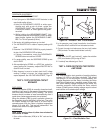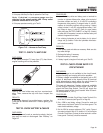
SSeeccttiioonn 77
DDIIAAGGNNOOSSTTIICC TTEESSTTSS
RESULTS:
1. If breaker is “ON” and “Continuity” is measured, go to Test 3.
2. If breaker is “OFF”, reset to the “ON” position and check for AC
output.
3. If breaker is “ON” and “Continuity” is not measured, replace the
defective circuit breaker.
TEST 13- CHECK LOAD VOLTAGE &
FREQUENCY
DISCUSSION:
If engine speed appears to drop off excessively when
electrical loads are applied to the generator, the load
voltage and frequency should be checked.
PROCEDURE:
Perform this test in the same manner as Test 1, but
apply a load to the generator equal to its rated capaci-
ty. With load applied check voltage and frequency.
Frequency should not drop below about 58 Hertz with
the load applied.
Voltage should not drop below about 115 VAC with
load applied.
RESULTS:
1. If voltage and/or frequency drop excessively when the load is
applied, go to Test 14.
2. If load voltage and frequency are within limits, end tests.
TEST 14- CHECK LOAD WATTS & AMPERAGE
DISCUSSION:
This test will determine if the generator's rated
wattage/amperage capacity has been exceeded.
Continuous electrical loading should not be greater
than the unit's rated capacity.
PROCEDURE:
Add up the wattages or amperages of all loads pow-
ered by the generator at one time. If desired, a clamp-
on ammeter may be used to measure current flow.
See “Measuring Current” on Page 16.
RESULTS:
1. If the unit is overloaded, reduce the load.
2. If load is within limits, but frequency and voltage still drop
excessively, complete Test 2, “Check/Adjust Engine Governor”.
If governor adjustment does not correct the problem, go to
Problem 8 (Flow Chart, Pages 34 and 35).
TEST 15 - CHECK BATTERY CHARGE
OUTPUT
DISCUSSION:
The Battery Charge system consists of a center tap
Battery Charge Winding, a Battery Charge Rectifier,
and a Battery Charge Resistor. During normal opera-
tion the battery charge output will vary between 1 to 2
amps, depending on the load applied to the genera-
tor. Battery Charge Winding Stator Lead Wire 66 is
tapped at the Battery Charge Rectifier and connected
to the Engine Control Circuit Board at Pin location J1-
10, and is used as a signal for Starter lockout.
PROCEDURE:
1. Disconnect Wire 15 from the Battery Charge Rectifier (center
terminal). Wire 15 is the fused battery supply.
2. Set a VOM to measure DC Amps. Connect the positive (+) test
lead to the center terminal of the Battery Charge Rectifier.
Connect the negative (-) test lead to Wire 15 previously discon-
nected.
3. Start the generator. The amp reading on the VOM should be
approximately 0.8 Amps. Apply full load to the generator. The
amp reading should increase to approximately 2 Amps.
RESULTS:
1. If amperage was measured between 0.8 to 2 Amps in Step 2
and Step 3, the charging system is working.
2. If no amperage was measured, check the VOM fuses and veri-
fy the functioning of the Amp Meter. If DC Amp Meter is good
and no current is measured, go to Test 16
TEST 16 - CHECK BATTERY CHARGE
RECTIFIER
DISCUSSION:
The Battery Charge Rectifier (
BCR)
is a full wave rectifier.
PROCEDURE:
1. Disconnect Wire 66, Wire 15 and Wire 77 from the Battery
Charge Rectifier.
2. Set the VOM to the Diode Test range. Connect the negative (-)
test lead to the center terminal of the BCR. Connect the posi-
tive (+) test lead to an outer terminal. The meter should mea-
sure approximately 0.5 volts. Now connect the positive test
lead to the other outer terminal. Again, the meter should mea-
sure approximately 0.5 volts.
3. Connect the positive (+) test lead to the center terminal of the BCR.
Connect the negative (-) test lead to to an outer terminal. The
meter should measure “Infinity.” Connect the negative test lead to
the other outer terminal. “Infinity” should once again be measured.
Page 45


















